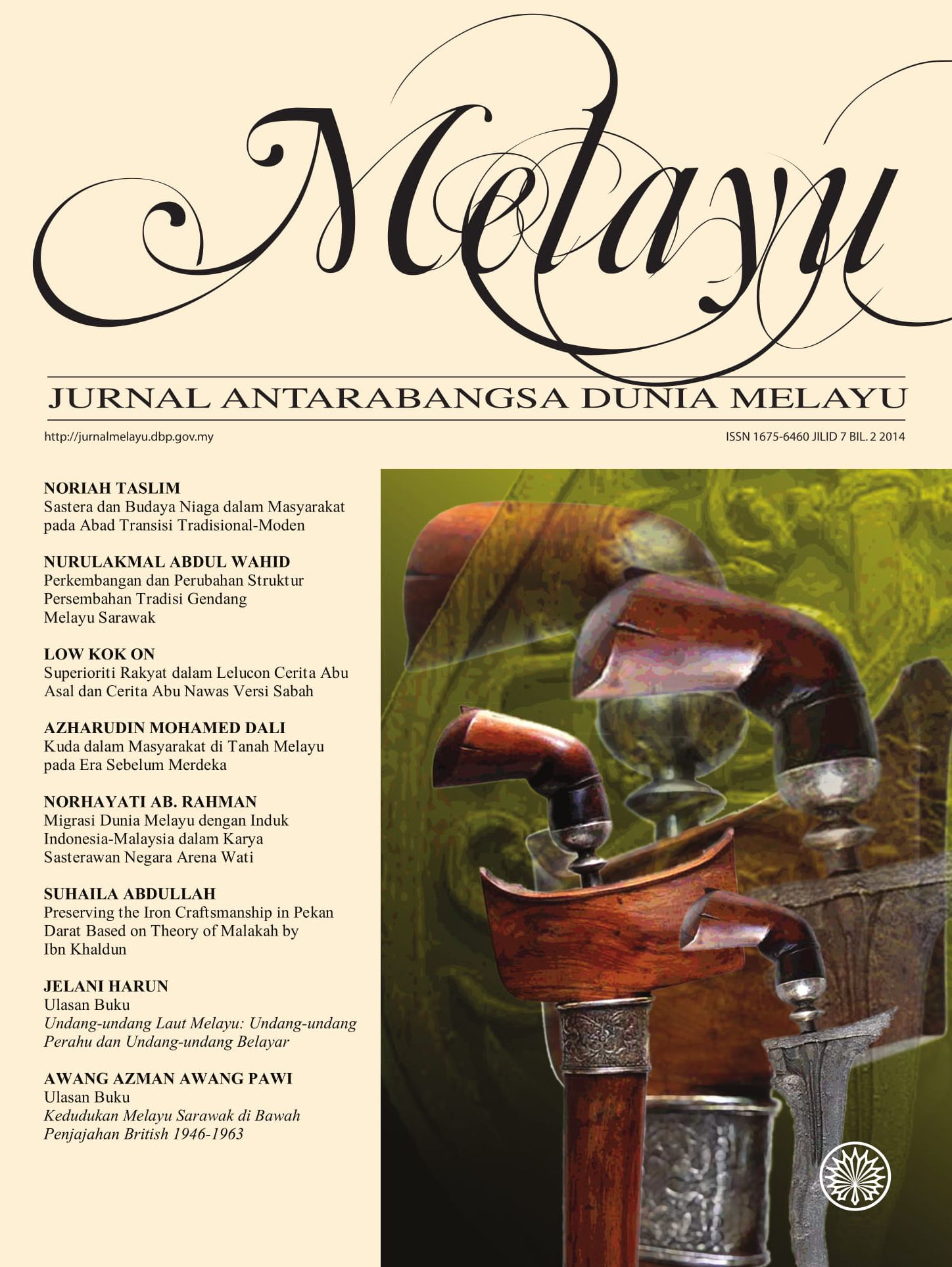The Folk Superiority in the Humour of the Original and Sabah Version of Abu Nawas Tales
(Superioriti Rakyat dalam Lelucon Cerita Abu Nawas Asal dan Cerita Abu Nawas Versi Sabah)
Abstract
The focus of this paper is to analyse the elements of folk superiority in both versions of Abu Nawas tales based on the Theory of Superiority. This study also attempts to track the spreads of Abu Nawas tales to Sabah. The tales of Abu Nawas are categorised as humorous tales from Arab and Persia amongst the folk-literature scholars of Malaysia. The spreads of Abu Nawas tales from Arab, Persia or India to the Malay Archipelago are closely linked to the spreads of Islam to this region in the 15thcentury. Drawing from field trips to collect folk tales in various districts of Sabah, it was noted that Abu Nawas tales are not only popular among the Muslim natives of Sabah like the Bruneian, Bajau and Suluk but also among the non Muslim natives of Sabah, like the Kimaragang, Rungus and Murut ethnic groups. However, In doing so, the feeling of folk superiority that was hidden in the humour of Abu Nawas tales will be revealed to the readers.
Keywords: Abu Nawas, humorous tales, Theory of Superiority, folk superiority
References
Awang Mohd Jamil Al Sufri, 1997. Survival Brunei dari Perspektif Sejarah. Pusat Sejarah Brunei Kementerian Kebudayaan Belia dan Sukan: Brunei Darussalam.
Boston, Richard, 1974. An Anatomy of Laughter. London: William Collin Sons & Co Ltd Glasgow.
Emeis, M.G., 1973. Bunga Rampai Melayu Kuno. Kuala Lumpur: Dewan Bahasa dan Pustaka.
Internet Encyclopedia of Philosophy. Humor dlm. http://www.iep.utm.edu/humor/. [Capaian 12 April 2014].
Keith-Spiegel, Patricia, 1972. "Early Conceptions of Humor: Varieties and Issues" dlm. Jeffrey H. Goldstein and Paul E. McGhee (edited). The Psychology of Humor Theoretical Perspectives and Empirical Issues Volume II Applied Studies. London: Academic Press.
Mohd Taib Osman, "Hikayat Abu Nawas: MSS 1652 di Pusat Manuskrip Melayu I 39" dlm. Jurnal Filologi Melayu Jilid 14: 1-63, 2006.
Monro, D. H., 1988. "Theories of Humor" dlm. Writing and Reading Across the Curriculum 3rd ed.: 349-55. Laurence Behrens and Leonard J. Rosen, eds. Glenview, IL: Scott, Foresman and Company.
Muller, Gilbert H. and Williams, John A., 1995. The McGraw-Hill Introduction to Literature. New York: McGraw-Hill Inc.
Muzium Sabah, 1992. Warisan Sabah: Pengenalan Ringkas Sejarah dan Warisan Sabah. Kota Kinabalu: Muzium Sabah.
Noriah Mohamed, 2007. "Si Paloi/Palui dan Si Luncai: Pukul Anak Sindir Menantu" dlm. Rogayah A. Hamid dan Wardati Md. Sheriff (peny.). Tradisi Lisan Manifestasi Cendikiawan Melayu. Kuala Lumpur: Dewan Bahasa dan Pustaka.
Noriah Taslim, 2003. "Gender, Kelas dan Hiraki dalam Cerita-cerita Jenaka Melayu: Pemindahan Dunia Nyata ke dalam Kerangka Olokan". (Kertas Seminar). Dalam Seminar Jenaka Melayu Nusantara: 1-15. Anjuran Akademi Pengajian Melayu UM dan DBP. Kuala Lumpur: Universiti Malaya. 21-23 Ogos.
Pollio, Howard R., 1983. "Notes Toward a Field Theory of Humor" dlm. Paul E. McGhee and Jeffrey H. Goldstein (ed.), Handbook of Humor Research Volume I Basic Issues: 213-230. United States of America: R.R Donnelley & Sons, Harrisonburg, Virginia.
Remak, Henry H.H., 1990. "Sastera Bandingan: Takrif dan Fungsi" dlm Newton P.
Stalknecth dan Horst Frenz, SasteraPerbandingan: Kaedah dan Perspektif: 1-45. Kuala Lumpur: Dewan Bahasa dan Pustaka.
Shaiful Bahri Md. Radzi, 2002. "Malay Humourous Tales: Performance, Corpus of Oral Text and Its Study". Tesis Ph.D. University of London: School of Oriental and African Studies.
Wan Shamsuddin, 1966. Hikayat Abu Nawas. Kuala Lumpur: Penerbitan Pustaka Antara.
Winstedt, R.O., "Hikayat Abu Nawas" dlm. JSBRAS 81 (9): 15-21, 1920a.
Winstedt, R.O., "The Indian Origin of Malay Folk-tales" dlm. JSBRAS 82 (9): 119-126, 1920b.
Wathiqah Amirah Hj. Wasli, 2012. "Si Paluian: Watak Trisckter dalam Cerita Jenaka Melayu Brunei". Tesis Ijazah Sarjana Muda. Universiti Brunei Darussalam: Jabatan Kesusasteraan Melayu, Fakulti Sastera dan Sains Sosial.








